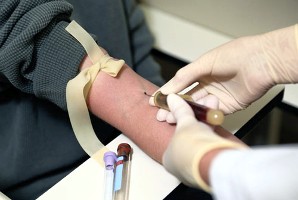A team of engineers from University of Toledo in Ohio has developed a low-cost, portable technique that can quickly detect specific proteins in a sample of human blood. Their technique is described in the 1 September issue of the journal, Biomedical Optics Express.
Human blood has thousands of different proteins essential to day-to-day life functions, or formed only in response to certain diseases. Knowing which protein indicates an illness and singling it out of a blood sample leads to earlier diagnosis and more effective treatment, for example the prostate-specific antigen (PSA), to help detect prostate cancer in men.
Current blood testing testing procedures, however, are expensive and time-consuming. Moreover, sophisticated blood testing equipment is bulky and difficult to transport.
The Toledo blood tests use artificially created molecules — short strands of nucleic acid — called aptamers to latch on to free-floating proteins in the blood, and like antibodies, attach to only one kind of molecule. Aptamers can be used to search out molecules both small and large, including complex enzymes, peptides, and proteins.
For the sensing medium, the researchers use a glass slide with a nano-scale layer (one nanometer equals one billionth of a meter) of gold. When the blood sample is applied to this test surface, the aptamer and their corresponding proteins latch together. For a demonstration, the researchers chose thrombin — a protein that plays a role in clotting — and thrombin-binding aptamers.
To detect if the pairing of aptamer and protein happens, the team uses Surface Plasmon Resonance (SPR), an optical sensing technique. SPR detects changes in the gold layer by measuring the resonance on the surface of the sensor. This method can quantify the amount of the target protein that is present in the blood sample, even at very low concentrations. The SPR technology used in this case is a compact, low-cost, entry-level device.
Toledo bioengeering professor Brent Cameron believes the technology can help in a wide range of medical sensing applications, including diagnosing diseases like cancer and diabetes long before clinical symptoms arise. “This method has the potential,” says Cameron, “to provide similar functionality of large and costly clinical instrumentation currently used to identify and quantify blood proteins for a fraction of current costs.”
Cameron estimates commercial use of this blood testing technology is three to five years away, given the required regulatory procedures and filings. The time frame, he notes, is dependent on the target applications; his team is identifying suitable aptamers for proteins used in cancer and diabetes diagnosis.
Read more: Engineers Build Compact Diagnostic Biosensor
* * *


 RSS - Posts
RSS - Posts
[…] Read more: Fast, Inexpensive, Portable Blood Tests Developed […]